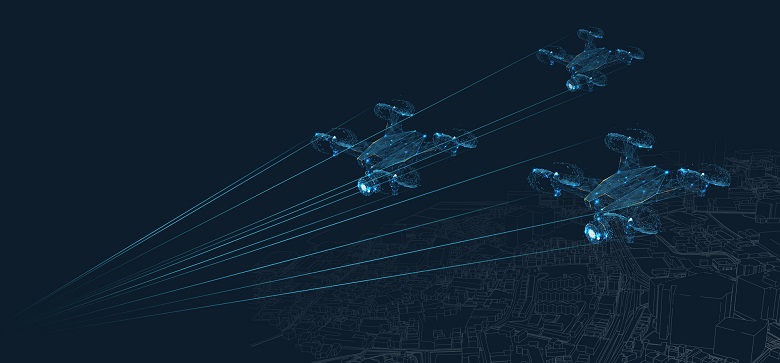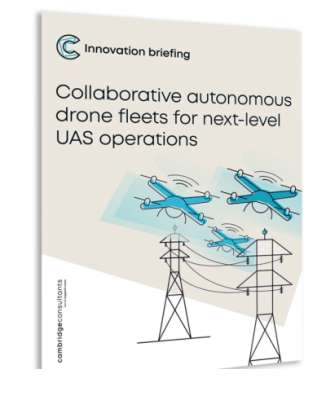A ground-breaking application of autonomy is ready to accelerate the public acceptance and commercial viability of uncrewed aerial vehicles (UAVs). The collaborative autonomous drone fleets created by Cambridge Consultants offer a new generation of UAVs with pilots on the loop, not in the loop.
The efficiency and safety of our collaborative fleet hinges on the autonomous capabilities enabled by our reinforcement learning algorithms. With a commitment to transparency and trust, we put together a comprehensive AI assurance methodology that was considered at every stage of this development to ensure any safety and ethical concerns were met.
Indeed, our live demo has showcased how effectively these fleets can work together to unlock commercial, safety, efficiency and cost advantages for a range of use cases. But inevitably the shift from simulated environments to real-world scenarios still presents many complexities left to be navigated. For us as technology consultants, tackling these complexities is the next step in our work as we help ambitious companies develop the technologies and platforms to deliver autonomous UAV services for complex operations.
Use cases of the collaborative drone fleet
In one scenario, the drone fleet inspects a potentially dangerous railway tunnel for faults.
Rail infrastructure inspection use case from Cambridge Consultants on Vimeo.
Working together, the autonomous fleet can tackle this hazardous and complex task with each fleet member taking on a different role. The fleet checks for hot spots in electrical panels or rail cracks, all while streaming information in real time to human inspectors who can adjust the task accordingly. Meanwhile, the UAVs can locally store larger data sets, such as 4D image captures, that can then be accessed after the mission.
Collaborative autonomous fleets could also provide transformative insights for smart farming, identifying undernourished or infested crops and treating them immediately to minimize loss. Meanwhile, soil samples can be taken, irrigation systems checked, and the overall health and yield of the crop predicted with greater accuracy.
Smart farming use case from Cambridge Consultants on Vimeo.
Similarly, in forestry applications, UAS can unlock illuminating data insights about the forest, helping to manage forest estates in support of net zero goals and to validate the resources associated with carbon credits.
In each of these use cases, the value is not about the drones themselves, but what they enable for our clients: enhanced safety, reduced loss, increased profits, and the capture of essential data in demanding environments. These data insights, when harnessed effectively, can optimize operational efficiency and success for a range of scenarios.
Next steps in unlocking operational value
1. Moving from sim2real
2. Anomaly detection for greater efficiency
3. Blended communication
4. Utilizing 5G private networks
Moving beyond the confines of controlled demonstrations, we are committed to tackling these challenges head-on. As we transition the fleet into real-world environments, our focus remains steadfast on harnessing this groundbreaking technology to enhance safety, efficiency and operational excellence for clients looking to develop autonomous UAV technology with a model of AI assurance at its core. To find out more about this exciting new generation of automated, collaborative UAV fleets and what they can do for your operation, download our recent whitepaper – Collaborative autonomous drone fleets for next level UAS operations – and reach out to continue the conversation.
About the author
Martin Cookson,
















Comments